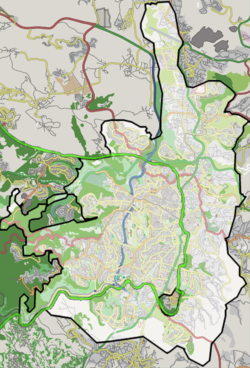
Back رحافيا Arabic رحافيا ARZ Rechavja Czech Rechavia German Réhavia French רחביה HE Ռեհավիա Armenian Rehavia ID Rehavia NB Рехавия Russian
Rehavia
רחביה | |
|---|---|
Neighborhood of Jerusalem | |
 International style architecture in Rehavia | |
| Coordinates: 31°46′28.11″N 35°12′43.19″E / 31.7744750°N 35.2119972°E | |
| District | Jerusalem District |
| City | Jerusalem |
| Founded | 1922 |
| Founded by | Jewish National Fund |

Rehavia or Rechavia (Hebrew: רחביה, Arabic: رحافيا) is an upscale neighbourhood in Jerusalem. It is bordered by Nachlaot and Sha'arei Hesed to the north, Talbiya and Kiryat Shmuel to the south, and the Valley of the Cross to the west.
Rehavia was established in the early 1920s on lands leased from the Greek Orthodox Church. It was designed by the German-born Jewish architect Richard Kauffmann, who envisioned it as a garden suburb inspired by garden city principles and the International Style.[1] The neighbourhood is marked by its tranquil character, achieved through narrow, curved streets intended to minimise traffic and commercial activity, which was limited to main streets. Early on, it attracted German-Jewish immigrants,[2] affluent Sephardic families, and key leaders of the Yishuv, earning a reputation as an aristocratic enclave. The neighbourhood has been associated with yekke culture.[2]
In the modern era, Rehavia remains a desirable residential area, known for its high property values. It continues to host many academics, doctors, judges, and public officials. The neighbourhood is home to national institutions such as the Jewish Agency, Jewish National Fund, and Keren Hayesod, and the home of former Prime Minister Levi Eshkol, and Beit Aghion – the Prime Minister's official residence. Historical buildings include the original residence of President Yitzhak Ben-Zvi, the Yad Ben-Zvi institute, Jason's Tomb, the Great Synagogue and the Yeshurun Central Synagogue.[3]
- ^ Zaidman, Miki; Kark, Ruth (2016-01-02). "Garden cities in the Jewish Yishuv of Palestine: Zionist ideology and practice 1905–1945". Planning Perspectives. 31 (1): 13–14. doi:10.1080/02665433.2015.1039051. ISSN 0266-5433.
- ^ a b Horstmann, F., "Minimalism and After Political, Poetic and Personal Revisions". 31: Women: Exhibition Concept after Marcel Duchamp, 1943, p. 19.
- ^ "Jerusalem's Rehavia neighborhood: A tapestry of culture, timeless landmarks". The Jerusalem Post | JPost.com. 2024-01-12. Retrieved 2024-06-02.
